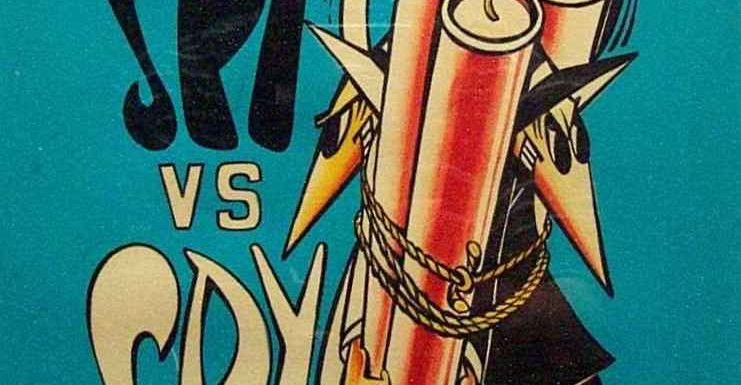
At the end of World War II mankind stared breathlessly into oblivion. Scientists had split the atom, and the Atomic Age had begun. In a matter of months warfare had transformed from year-long conflicts between infantry, to weapons that could vaporize a civilization instantly.
The world was paralyzed with fear. Any provocation could lead to global decimation with a press of “the button.” Science had finally taken the hassle out of combat.
Tanks now sat rusting as spies took to the front lines to wage a secret battle of information pilfering. The Cold War had begun, and intelligence was the ammo.
American school children drilled constantly, taking shelter beneath their nuclear blast-resistant desks, as their mothers and fathers were swept away to Eastern Europe in the national spy draft.
From the ashes of Japan the world had been reborn. Surveillance, counter-surveillance, and counter-counter-surveillance were now the norm. False identities concealed false real identities as everyone observed and reported on everyone else, sometimes even themselves.
By the Spring of 1947 eighty-five percent of the world’s population was employed as a covert operative. The remaining fifteen-percent worked as mall Santa Clauses.
The postal service was choked with coded messages disguised as song lyrics, grocery lists, and suicide notes. Spy agencies couldn’t process the information fast enough. The time spent coding, transmitting, and decoding messages was costing the United States a fortune, and they were desperate for a solution.
The answer sprung from a think tank that was having a going out of business sale, “Show the spy documents to everyone” was their solution. It was insane, but they were running out of time, and the think tank didn’t offer refunds.
At the insistence of the IRS, Mad Magazine volunteered to help; and Spy Vs. Spy was born. Twice a month, a classified report was printed in its pages, hidden in plain sight.
The American public looked at Spy Vs. Spy and laughed, not realizing that the brutal acts depicted in each comic was a literal reporting of what was happening overseas. Agency directors would host meetings, each member reading Mad Magazine and gasping at the shootings, stabbings and other grisly deaths in the comic.
The creator, Antonio Prohias himself became entangled in the world of cloak and dagger. For years he transcribed the violent reports into a comic strip and subsequently became a master of the craft. He quickly began planting false reports in the strip, creating increasingly bizarre, and impractical situations.
The spy community were surprised at first to see depictions of such ridiculous mayhem. But as issues kept appearing on newsstands with the same type of comic violence, they accepted the scenarios to be real. Soon, it was no longer ludicrous to attack someone with a cream pie, or rig their alarm clock to fire a gun. Spies spent hours, sometimes days, setting up esoteric Rube Goldberg scenarios to capture, or just embarrass an enemy.
As time wore on, the spy world began to collapse. Spies took to wearing colors indicating their allegiance as they did in Spy vs. Spy, thereby breaking cover. They offered each other poisoned martinis, followed each other into concealed bear traps, and stumbled into spike pits.
What had once been dashing, sexy, occupation had devolved into a comic parody of itself. Spies were dying from accidentally ingesting sticks of dynamite, being hit in the face by boxing gloves attached to springs, or turning a doorknob attached to a light socket.
The world had changed again, but this time not with a bomb, but with the stroke of a cartoonist’s pen. The spies, now identifiable, were all arrested, and life returned to normal. Parents returned home and began the laborious task of raising their now feral children. The nuclear threat gone, the world could breathe a well deserved sigh of relief.
Editor’s note: Antonio Prohias is currently serving eight hundred life sentences for tricking a spy to look into a mail drop and then spraying him with a seltzer bottle.
The sentencing is so harsh because of the International Spycraft Treaty of 1967 which requires a minimum incarceration period of 500 years if a seltzer bottle is used to humiliate a covert government agent.
Interested in Jonas Polsky? Chat, flirt, and more, at twitter.com/JonasPolsky